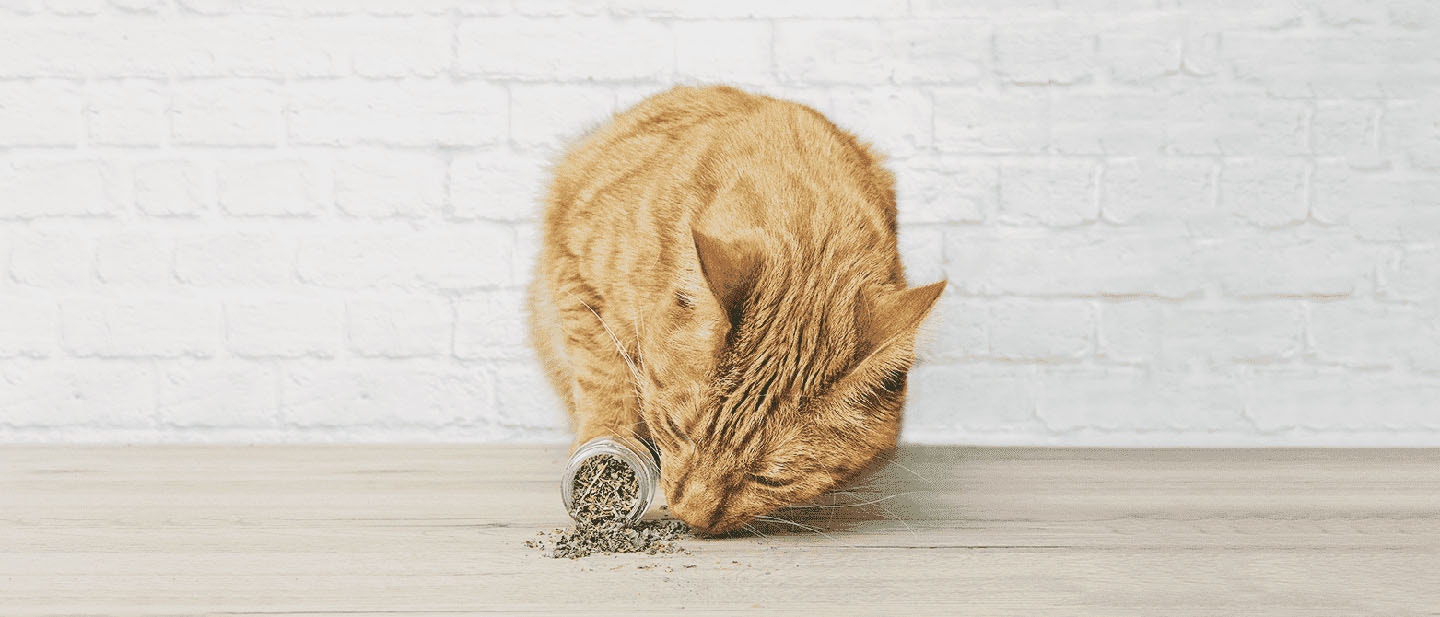
What Is Catnip? It's Uses and Effects
Catnip is the one thing that can render a cat helpless with excitement. It encourages your cat to play, exercise and generally feel good. But why does catnip attract cats, and how can you use it to keep your cat happy?
Have you ever thought, what is catnip, or what is catnip used for? As a cat parent, you are surely aware of the effects catnip has on fur babies. If you are not aware, then we strongly suggest you watch some videos online. Catnip and furries make for a hilarious combination. Most kitties are triggered by catnip, and roll over or rub themselves against catnip or catnip infused objects.
Let us find out more about catnip and how it impacts your furry munchkin.
What is catnip?
Catnip, or Nepeta Cataria is a perennial plant belonging to the mint family. It is found in most abundance in sunny regions, including North American states and certain regions in Europe. One of the active components of the catnip plant is nepetalactone, an agent that causes fur kiddos to respond to it. The nepetalactone chemical is produced by the plant in small quantities which coats the leaves, seedpods, and stems of the plant. The seedpods often rupture, causing cats to be attracted to them.
Catnip plants are wildly found in areas with well-drained soil. They are grey-green plants that have jagged heart-shaped leaves, and thick stems covered with fuzzy hair-like growth. And now that you know what is catnip, let us find out how it affects feline furries.
What does catnip do to cats or How does catnip work?
The nepetalactone chemical produced by the catnip plant is a known agent that attracts and triggers the response and brain function in cats. The chemical, upon entering through a cat’s nose can serve as a stimulant and influence its responses. Most fur kids roll around or rub against objects that has catnip.
Nepetalactone generally overcomes the olfactory sense in cats, causing the sensory neurons in the nasal cavity to be activated. This can further influence the pleasure centres in the cat’s brain, leading to a change in the emotions and behaviours of the little munchkins. Though the effect of catnip usually stays for 10mins to 15mins, it can have different results based on whether your cat had smelled it, or had ingested it. And this is what catnip is.
Feeding catnip to cats vs cats smelling it
Most furries prefer smelling catnip rather than ingesting it. This is because catnip enters the nose and triggers the sensory signals in the nose. Smelling catnip usually has the desired result in the pleasure points in the brain, and is akin to a sexual response. Therefore, most cats prefer smelling catnip for cats rather than eating it.
However, smelling catnip also causes nepetalactone to take over the cat’s olfactory senses, leading to hyperactivity or ecstasy. Most cats, under the influence of catnip rub against objects or roll around on the floor. However, there are several benefits of your cat smelling catnip. While catnip causes hyperactivity, it also helps relieve stress.
Cats can eat catnip. However, eating catnip for cats rather than smelling it can lead to a result quite different from hyperactivity. If ingested, catnip serves as a sedative, and is extremely beneficial for aiding anxiety or treating insomnia. Eating catnip can also help in clearing your fur baby’s bowels, but too much catnip can also result in an upset stomach.
Do all cats react to catnip?
Are you wondering, do cats like catnip or what does catnip do to cats? Not all cats are able to identify or respond to the effects of catnip. Studies show that only about 50% to 70% of furries around the world are influenced by catnip. This is because genetics play a major role in determining your furry friend’s preference for catnip. If a fur kiddo isn’t born with the genes to identify catnip, catnip is unable to make any effect on the cat.
How long does the effect last?
In adult cats, the effect of catnip usually lasts for around 10 minutes. However, it takes almost two hours for your cat to completely recover from its effects. This effect usually depends on the age and tolerance of your feline buddy.
Catnip usage instructions for cat owners
If you are wondering is catnip good for cats, with the following tips about catnip usage, you can ensure the right amount of catnip for your little munchkin:
Dosage quantity
Before determining the dosage of catnip to give your cat, you can start with the smell test - rub catnip on their toys and see how they react to it. If your cat shows the expected results, you can get them introduced to catnip in small doses. Most cat parents usually start by adding a teaspoon or tablespoon of dried catnip to a bowl and setting it before your munchkin. Depending on their response, you can alter the dosage. Smaller kittens, however, should be given smaller doses, such as lesser than a teaspoon.
Dosage frequency
In order to ensure that your feline friend is able to enjoy catnip without getting desensitized to it, you must plan gaps between indulging them to catnip. Usually, the catnip effect stays in cats for over 2 hours before they can be affected again. It is generally recommended to give your cat catnip during their playtime, twice or thrice a week.
Storage instructions
Once dried, the catnip herb needs to be safely preserved in airtight containers to avoid moisture from getting in. Airtight zipper bags made of plastic are usually perfect for storing catnips. You can ensure your catnip stays preserved for long by keeping it in a cool, dry place away from direct sunlight or heat, as it diminishes the potency of the herb. You must also make sure that the catnip is safely stored away from your kitty’s reach.
Where to buy catnip?
Catnip is widely available for cats across the world. You can buy for catnip from a pet store near you, or you can also purchase catnip for your cat by placing an order on eCommerce sites. Catnip is usually extremely cost-effective and can by afforded by all.
How to grow catnip yourself Catnip (Nepeta cataria) is a popular plant most sought after by cat parents. Catnip as an herbaceous perennial is native to North American states. Over time, it has become a popular plant to have at home for cat parents as they are low maintenance, and are incredibly easy to grow and have at home. You can grow catnip yourself by following these tips:
When to plant
Catnip prefers a sunny atmosphere. So, the ideal time to plant catnip is during the spring when the frosty winter months have gone by.
Where to plant your catnip
As mentioned, catnip requires a lot of sunlight to grow and reach its best potential. A wide-open space that receives sufficient sunlight during the daytime hours is best for planting catnip. A garden with plenty of sunlight and well-drained soil is beneficial for catnip. However, if you live in a region with a hot, arid climate, it is important to offer your catnip some shade from the harsh afternoon sun.
Watering your catnip
As catnips are drought-tolerant plants, watering them excessively can be detrimental. Instead, you can water your catnip plant in small amounts to ensure that the soil around the plant is moist, yet not soggy. Once planted, your catnip plant will be prepared to be introduced to your feline friend within the year.
Training your cat with catnip - what is catnip used for
If you're thinking what is catnip used for, you're in the right place. Domestic fur kids often respond positively to training, and can be easily trained at home. As a cat owner, you can also use catnip toys to stimulate their activities and train them better:
Catnip toys
Fur babies are playful creatures, and respond well to play sessions. As cats have a natural affinity for catnip, many cat parents often use catnip in cat toys to make them more attractive to cats, who love interacting with them. Simply put, catnip toys are toys that contain catnip, and are specifically designed for feline friends. You can make a toy you’ve purchased for your cat more appealing by rubbing catnip over it. Catnip toys are available for commercial purchase and come as chew toys with the catnip herb packed within. You can also prepare a DIY catnip toy for your little munchkin at home from scratch! You simply need an old sock, pour dried catnip herb within, sew or tie the open end, and voila! A catnip toy is ready for your feline friend to dig into. However, your cat’s response to the catnip can vary depending on the type of catnip used, for cats often have a greater preference for fresh or dried catnip, than catnip sprays. This is because commercially available catnip sprays do not contain nepetalactone that stimulates the cat’s sensory centres.
Training instructions
Catnip usually provides a strong stimulant for cats, and is therefore used by most trainers as an agent to train their fuzzballs. Most cats have a tendency of scratching furniture to sharpen their claws. You can train your cat to give up scratching furniture by redirecting them to scratching posts sprinkled with catnip herb. You can also train them to get acquainted with new cat beds by sprinkling small amounts of catnip on cushions and making them more appealing to your cat.
Catnip can be also used as an agent to condition cats while training. You can also use catnip as a positive reinforcement for a job well done, and encourage them to pick up training faster than ever. You can also add catnip as a vital part of your teaching regimen and help your cat learn amazing feats.
Catnip FAQs:
-
Why do cats love catnip?
Cats are known for their affection for catnip. Recent studies in this regard have shown that nepetalactone, an integral component present in catnip is responsible for this affection. Catnip is a plant that belongs to the same family as mints, and nepetalactone, often enters a cat’s nose, stimulating its sensory neurons. Nepetalactone is known to mimic a cat pheromone, which sends trigger signals to the brain mimicking a sexual response. This is why cats love catnip.
At what age can you give catnip to a cat?
There is no specific age to introduce a cat to catnip. Though catnip does not have any detrimental effect on kittens, it takes the cat to be at least 6 months or 1 year of age to receive the desired reaction from catnip. However, some cats are exceptions to this, as their sensitivity to catnip can take time and develop over the years.
Can cats overdose on catnip?
Though there have been no such instances that suggest the possibility of a cat overdosing on catnip. However, once already under the influence of catnip, it usually takes a cat a duration of two hours or more before it can once again experience the influence. Overindulgence, however, can be a problem, as your furry munchkin can fall sick if it has eaten too much catnip.
Is catnip safe?
Have you ever thought what is catnip, or whether it is safe for cats? Catnip is widely popular among cats. There has been no evidence that supports the claim that catnip is harmful or detrimental to the cat’s health. However, if you are granting your little furball access to catnip, make sure they do not ingest too much fresh or dried catnip, as it can upset their bowel system. This, however, does not always pose a severe threat as most cats are able to self-regulate.
